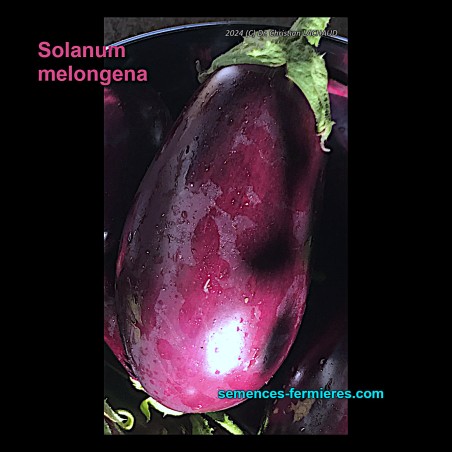



Solanum melongena - Eggplant
1 Packet of 40 Seeds
-
Solanum melongena is an Asian Solanaceae
It was probably domesticated in the India-China area from a wild species, Solanum insanum, itself resulting from utilitarian selection for tannery, of Solanum incanum (north-east and east of Africa, Arabian Peninsula, then Iran) - the ancestors of this lineage coming from tropical Africa (Solanum campylacanthum, Solanum lichtensteinii)
Solanum melongena is grown for its large edible and delicious fruit, Aubergine, generally eaten cooked, but which can also be eaten raw when young
There are several varieties which vary in size, shape, and color of their fruits (small vs. large, spherical vs. elongated, white-yellow vs. purple-black vs. green vs. streaked), as well as in adaptation to local climatic conditions
Solanum melongena deploys very large leaves (30 x 25cm), downy, glaucous green, entire or slightly crenate
They are borne on a woody and very solid stem, which branches dichotomically to create a small shrub generally not exceeding 1m in height
The plant's habit is erect, then spread out under the weight of the fruits
Eggplant has robust and painful thorns distributed sparsely on its stems, petioles and veins, and at the base of the fruits, requiring some precautions when harvesting and preparing in the kitchen
Large purple flowers with a contrasting bright yellow heart, very beautiful, appear at the base of the leaves, generally grouped in inflorescences of 2 or 3, including 1 or 2 male flowers which will only produces pollen, and a female flower which will produce a fruit after fertilization (female flowers also produce pollen, but not much)
Pollination is ensured by insects outdoors
If you grow Eggplants in a greenhouse without insects, you will have to pollinate the flowers manually
Eggplant has medicinal properties: Anticholesterolemic, Astringent, Narcotic
Like most Solanaceae, the leaves and stems of Solanum melongena contain toxic alkaloids and should not be eaten
The variety offered here is our selection fixed over the years and identically reproducible by sowing
Of the "Imperial Black Beauty" type, it produces large, delicious, purple eggplants, with light, firm, aromatic flesh, with an elongated and swollen shape, which can measure 25cm and reach 1 kg
Each plant bears 2 fruits simultaneously on average, for a total of around ten over the season
-
Sow the eggplant seeds in warm, in March or April, in potting soil, 2 or 3 seeds per pot, 0.5cm deep
Keep the substrate moist and expose to sunlight
Under these conditions, germination occurs in 10-15 days
After the first true leaves have developed, keep only the most vigorous seedling per pot
Grow in the nursery until the last frost, then plant in the ground
Full sun exposure preferably sheltered from the wind, in clean, well-worked soil, enriched with manure compost, drained, but always fresh
Water so that your eggplant plants never go thirsty
(Solanum melongena has large leaves and therefore looses a lot by evapotranspiration)
Flowering starts at the end of June or beginning of July and continues uninterrupted until the weather gets cold
Fruits follow quickly and are to be harvested while still young and tender
More mature fruits have a thicker skin that may need to be peeled, and the seeds start forming, which can be considered undesirable although going relatively unnoticed after cooking
The last fruits can be harvested in October when the autumn is not cold
We recommend growing around ten plants for providing enough eggplants over the season, for a household of 2 members
No noticeable cultivation difficulty
Slugs and snails may appreciate young fruits
Some Caterpillars can pierce the stems and dig a gallery
Stink Bugs can bite leaf petioles and young stems, causing upper leaves to wilt
In a humid greenhouse, leaves, flowers and stems can be attacked by mold
In a dry greenhouse, red spider mites can invade plants and cause damage
In greenhouses, Whitefly can be a problem
Therefore, prefer to grow your eggplants outdoors
-
Each plant produces around ten large fruits over the season
However, it will never bear more than 2-3 fruits at a time, and it will not produce more if fruits are not harvested
(inhibition mechanisms)
To avoid this normal loss of productivity, harvest the eggplants when they are still young
You might also like
Payment :
PayPal < 150 €
Check < 850 €
Bank Wire > 149 €
Thank you for your kind understanding